UX/UI Design
Paradino. ai
The Journey from Raw Recordings to Streamlined AI-Driven Documentation
Overview
When Paradino.ai began...
…, the problem was clear: financial advisers were spending too much time on meeting notes and compliance documentation, time they could have spent with clients instead. The founders had already spoken to many advisers during discovery interviews and learned that while meeting recordings were common, writing accurate, compliant notes from those recordings was time consuming.
With this insight, we had a starting point: automate the file note process using AI transcription and summarisation. What followed was a story of continuous learning, iteration, and user-centred design.
Process
The Journey
Discovery
Understanding the users was critical to designing a product that would be both trusted and relied upon. I interviewed financial advisers and paraplanners to learn about their workflows. Some common pain points emerged:
- Manual note-taking consumed hours per client, leading to inefficiencies.
- The most common meeting types were: Initial Discovery, Fact Find, Review and SOA Presentation
- Compliance required custom templates, but existing tools lacked flexibility.
- Trust in AI was a barrier—users needed clear ways to verify and edit AI-generated notes.
Additionally, I conducted a competitive analysis to identify opportunities for Paradino.ai to stand out from note takers and paraplanning tools.
How Might We?
Before building the MVP, we reframed user insights into actionable design challenges:
How might we reduce the time advisers spend on compliance documentation while ensuring accuracy and customisation?
How might we build trust in AI by providing transparency and control over AI-generated content?
How might we integrate seamlessly into existing adviser workflows with minimal disruption?
These guiding questions helped us prioritise features and envision solutions that aligned with user goals, laying the foundation for a user-first product strategy.
User Flow Chart
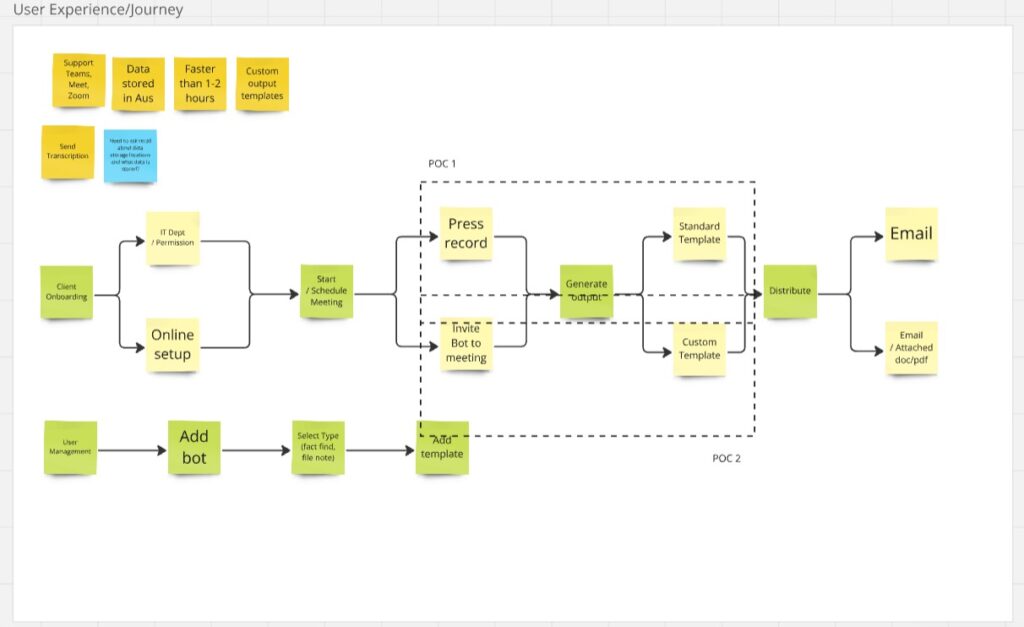
We mapped out the intended user journey to translate research insights into a clear and intuitive structure. This flow chart guided the MVP design, focusing on critical features that streamlined the user experience.
The First Release: AI-Powered Summaries
With limited resources and time, we prioritised automating meeting notes as the core feature. This MVP approach enabled us to gather feedback quickly, validate the concept, and deliver immediate value.
Our initial release focused on solving one core issue: turning spoken words into structured, editable notes.
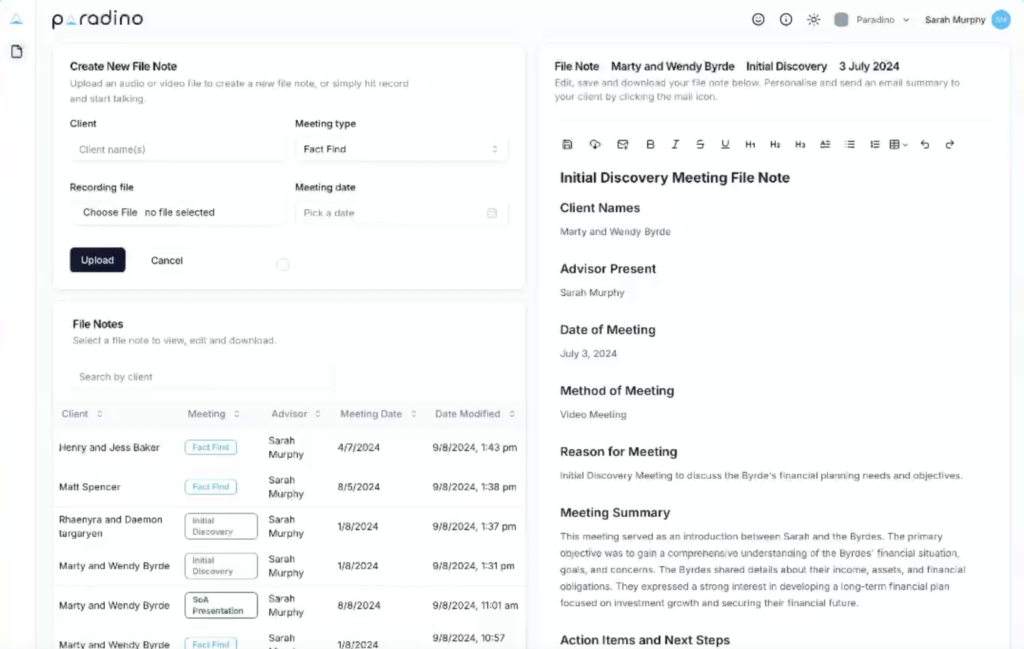
Key functionalities included:
- Upload an audio or video file.
- Pick from 4 standard templates
- Receive AI-generated transcripts and meeting summaries, for easy review and edits.
The response was positive—advisers saved hours on documentation—but it also uncovered new challenges.
Iteration 1: Recording Directly in the Platform
Users initially had the ability to upload recordings, which offered flexibility but also revealed a challenge:
“Sometimes I don’t record my meetings in Google or Zoom when it’s an inperson meeting. Can I use the app?”
Therefor we introduced the ability to record directly within the platform, eliminating the need for external tools. Additionally, after observing screen recordings some clients tried to upload non supported formats so we expanded support for additional audio and video formats, improving accessibility and user experience.
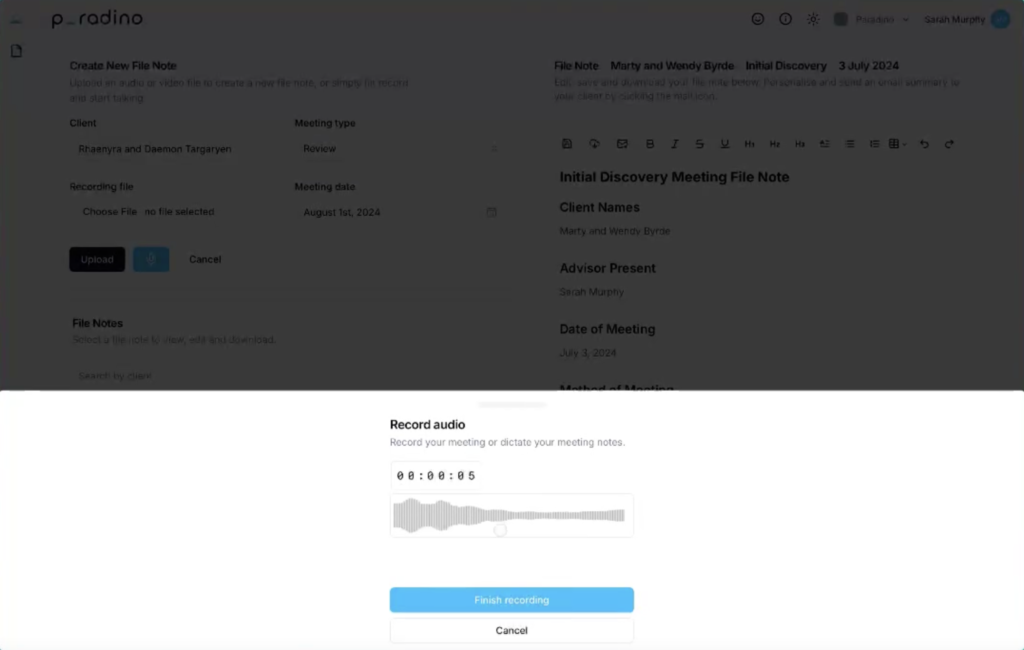
The first iteration, adding the record in app feature.
Iteration 2: Custom Templates for Compliance
It didn’t take long to realise that while AI-generated summaries were helpful, compliance formatting was a major roadblock. Users often had to copy-paste summaries into external documents to meet firm requirements:
“This AI-generated content is great, but the existing templates are not always what I need. Can I use my own templates?”
In response, we built a template integration feature:
- Users could upload their firm’s templates.
- AI-generated summaries would automatically format into the uploaded templates.
This update made it possible to generate fully compliant, branded notes, transforming a time-saving tool into a compliance-ready solution.
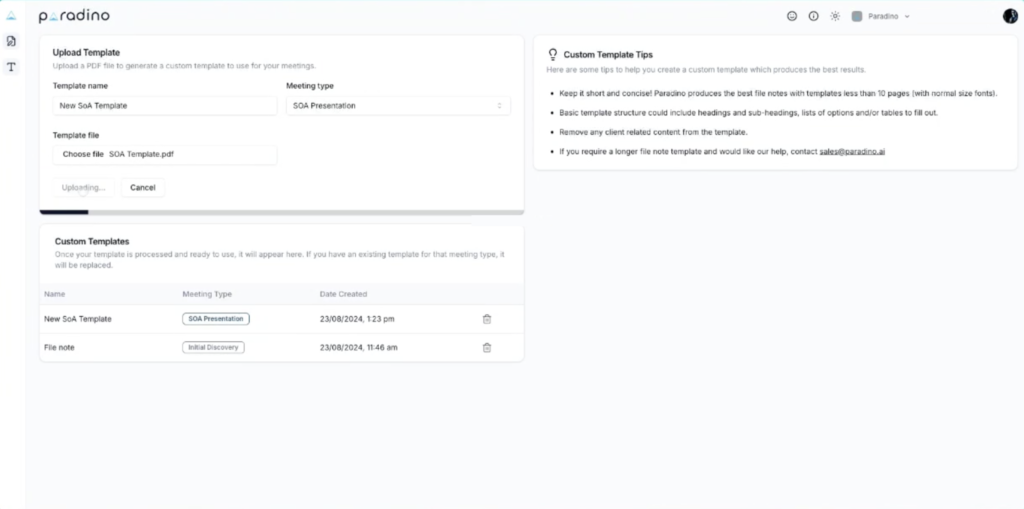
Adding the feature to allow clients to create custom templates.
Iteration 3: AI-Prompting for Personalisation
Advisers needed more control over note customisation:
“Can I get help to format a specific sections to match my preferences?”
In response to user feedback, we introduced an AI-prompting feature that allowed users to give specific instructions on how they wanted certain sections of their notes to look and read as well as get help to extract insights from the notes.
This feature provided users with more control, enabling them to customise the output to better suit their preferences and compliance requirements.
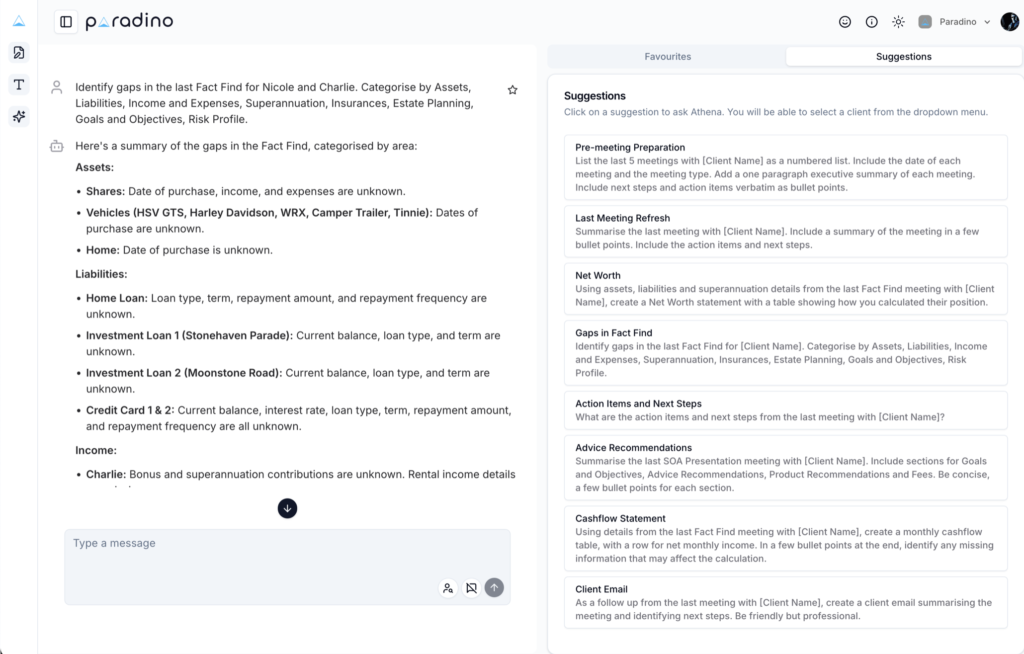
Tapping into Athena by allowing users to prompt the AI.
Reflecting on the Journey
Looking back on our journey, every decision was shaped by the need to understand and adapt to our users. For instance, when we faced the challenge of custom templates for compliance, we didn’t rush into building a feature based on assumptions. Instead, we decided to monitor how often clients attempted to upload longer templates. By encouraging users to reach out if they needed more than the 10-page limit, we gained valuable insights. It turned out that this need was less frequent than we expected, allowing us to prioritise a more targeted solution. This approach helped us refine our features based on real user behaviour and needs, rather than hypothetical cases.
The journey was about being flexible—pivoting based on feedback and evolving our product in line with user requirements. Each iteration was an opportunity to learn, improve, and ultimately deliver a product that truly met the needs of financial advisers.
THE RESULT
Impact and Outcomes
Time Saved, Compliance Confidence Gained
Paradino.ai transformed the way financial advisers handle documentation. What once took hours is now a streamlined, AI-driven process that delivers speed, accuracy, and customisation. The impact speaks for itself:
- Time Saved: Advisers now complete file notes up to 80% faster, reclaiming valuable hours to focus on client relationships rather than administrative tasks.
- Compliance Confidence: Custom template integration ensures that file notes meet firm-specific compliance requirements, eliminating the need for manual formatting or external tools.
- Increased Control and Personalisation: AI-prompting and custom template features allow users to tailor outputs to meet unique preferences and regulatory standards, making automation flexible and user-friendly.
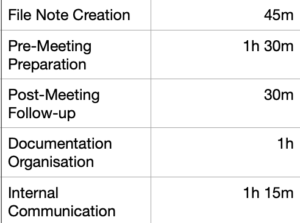
Next steps
The initial release of Paradino.ai has significantly reduced time spent on documentation and boosted compliance efficiency. However, there are more opportunities to enhance the experience. The next steps will focus on deepening automation, enhancing integrations, and providing users with more comprehensive tools.
Future enhancements include:
- Actionable Insights with Athena: Expanding Athena’s capabilities to not only generate insights but also take direct action. For example, Athena will enable users to assign tasks to team members and automate follow-ups, turning insights into action with minimal effort.
- Seamless CRM and Financial Software Integrations: Strengthening integrations with key financial service platforms and CRMs to create a unified experience that eliminates manual data entry and improves workflow efficiency.
- Multi-Recording Support for Unified Documentation: Enabling the upload and consolidation of multiple recordings into a single file note. This enhancement will allow users to create comprehensive records for cases involving separate discussions across different meetings.
Key Takeaways
User-Centric Design is Essential. The success of Paradino.ai was driven by the deep understanding of users’ pain points and workflows. Constant user feedback, both qualitative and quantitative, was critical in shaping the product to solve real-world problems efficiently.
Customisation Drives Adoption. The more flexibility users had in how their notes were formatted and presented, the more they engaged with the product. Offering customisable summaries and templates ensured that users could tailor the output to meet their unique needs.
Feature Requests Should Be Valued: Listening to users’ feature requests allowed us to prioritise valuable additions, like being able to download the audio recording. This reinforced that a product should always evolve based on user needs and emerging market trends.
